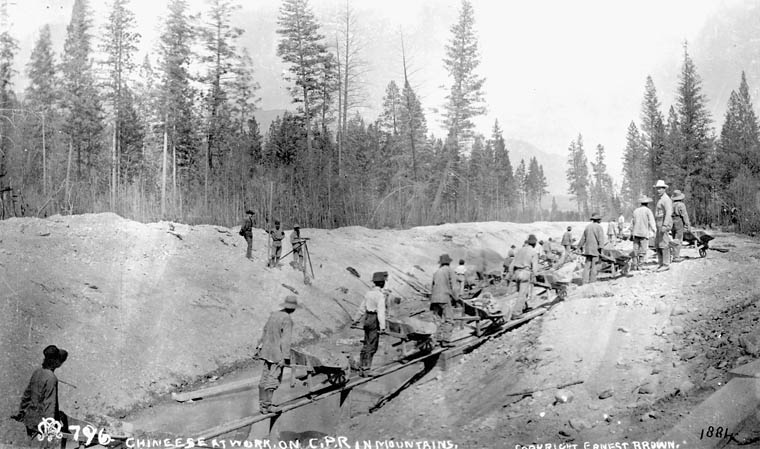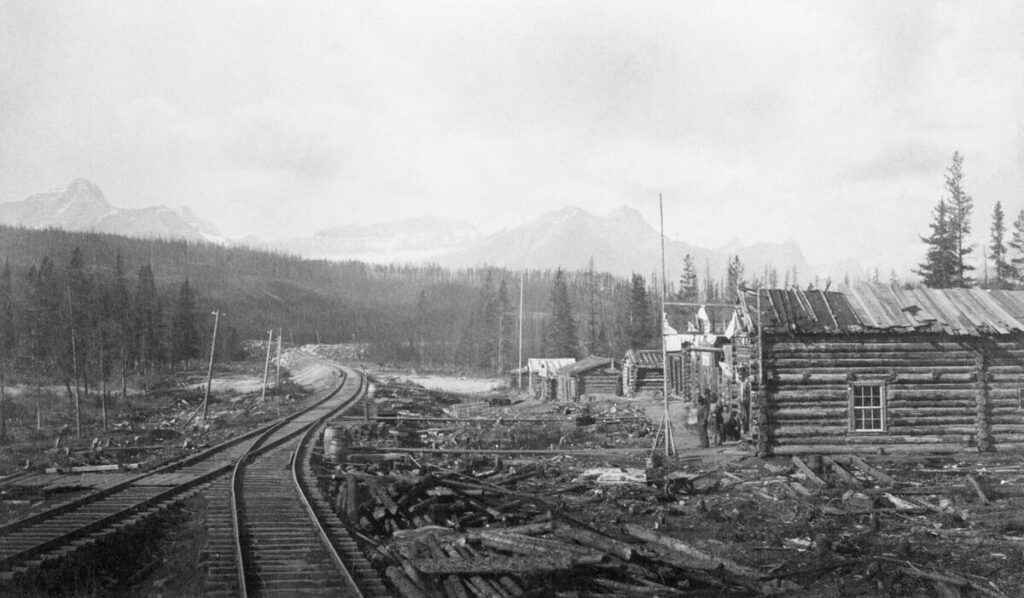A Deck of Dog Eared Cards

Boorne & May. Library and Archives Canada, C-006686B/Boorne & May. Bibliothèque et Archives Canada, C-006686B
This area. That we love and have come to call home wasn’t always the wondrous place that it is today. There was a time, 130 or so years ago when there were no roads., trails coming through the area were used mostly by the Aboriginal people, primarily the Ktunaxa and the Secempwec, and buy a few trappers and traders who used the rivers for transportation and the trails as links to the rivers.
The promise of a transcontinental railway had been a major factor in British Columbia’s decision to join Canadian Federation in 1871. However, successive governments mismanaged the project and by the original deadline of 1881, little of the railway had been completed, resulting in threats of succession by some BC politicians. The work was then assigned to a newly incorporated CPR company, which was allowed an additional ten years to complete the line, and did it in five.
So, work went really easy across the prairies, but once they reach the edge of the mountains, it’s slowed to a crawl. Many more men were brought on board to ensure the work was quickly completed. I have to say that the CPR gangs did a magnificent job of laying track. In fact, not far from Bow Gap, where the roadbed headed for the Kicking Horse Pass, the CPR gang managed to lay 600 feet in four minutes and forty-five seconds. A considerable feat by any gauge. If that sounded like a competition is because it was. The Northern Pacific, in an attempt to speed up their gangs, had had two gangs compete against each other. Their best time – 6 1/2 minutes.

End of track was established at Holt City in the fall of 1883, later became known as Laggan, and today is Lake Louise. For all the all of the summer of 1884, the construction headquarters was at Holt City while the rail was being driven across the Prairie. There was no permanence. Tents were set up and moved either every day or every other day, but once they hit the mountains, the tents gave way to sidings, log huts and mud huts, shanties fashioned out of rough planks, and in some cases, there was even hand-hewn log floors. Men were packed into these places like sardines.
Think for a minute, what it would’ve been like. Most of these men worked 10 to 14 hours a day, every day. There were no bath houses. The smell of the unwashed bodies, covered in wool, and perfumed, with strong tobacco. Would not, by today’s standards, be attractive to anybody. And yet these men were attractive to the gamblers, whiskey peddlers, prostitutes, and criminals that followed the rail looking to relieve a working man of his pay.
Some of the first structures built were recreational facilities. Recreation for the almost totally male population almost always meant the triple-W vices of the frontier: whiskey drinking, whoring, and wagering.
Salons, brothels and gambling halls would appear almost overnight. In the early camps, the structure might be only a lantern lite, dirt floored tent, the bar simply a board stretch between 2 whiskey barrels. The prostitution facility just a cot in a wagon bed for the use of a single female strumpet. The gambling outfit, only a rickety table, a few chairs and a greasy, dog-eared deck of cards.
As the number of salons or recreation facilities increased, the amount of rail that was being laid decreased. The men were all distracted or hungover and unable to work. In British Columbia there was twenty-mile jurisdiction that limited were alcohol could be sold. That’s 10 miles on either side of the survey track. Within those confines liquor couldn’t be sold. It was still legal to possess liquor. You just couldn’t get caught selling it. The act was instituted by the federal government under an act for the preservation of peace on public works. Bartenders could be fined for the first and second offences and jailed for the third. This 10-mile belt was however, within easy walking distance of these working men, fat paychecks in hand. Sam Steele recognized the problem and urged Ottawa to increase the distance, which they did, bringing it to 20 miles on either side of the surveyed line.
Of course, this law just encouraged men to break it. And soon the bootlegged liquor was coming over the mountain passes. Passes that were given names like the Whiskey Trail, which many of you may know a little bit about. It also created another problem. The distance at 20 miles while it was prohibitive meant that it was hard to send a constable out to keep tabs on the patrons of such places. Places like the Hog Ranch Hotel, for instance. It was built far enough outside the railway belt that the ownership wasn’t bothered. It was thanks to the hotel that the mountain and the Creek here got its name. When a dignitary and his wife were traveling down the valley to Lake Windermere, where a lot of well to do’s had property. The missus, looking out at all the drunks lying on the ground outside the hotel, said it didn’t look like any hotel she had ever seen and it just looked like a place for the hogs to live. Any money that they had left after buying alcohol was usually lost to the professional gamblers. And where there was booze, there was money. And where there was money, there were events like the murder of Robert Baird.
On November 27th, 1884 on the Kootenay Trail south of Golden, BC the infamous outlaw named Bulldog Kelly, ambushed and killed Robert Baird. A salesman for an American liquor company. Baird hired local guide and outfitter Manuel Dainard together with a packer named Henry to escort him safely back to Montana with the seasons liquor sales of $4500 in cash and gold. Shots rang out through the early morning quiet, killing Baird and wounding Henry. Unarmed and unaware that Henry was still alive, Manuel Dainard set out to get help.
Taking the money and leaving Henry for dead, Bulldog Kelly disappeared into the rugged countryside.
Manual Dainard reached Golden had about the same time as a battered, bleeding, Henry was discovered on the ground. Joined by outraged construction workers, posses were formed with the Northwest Mounted Police and the Provincial Police. A description of Kelly read, “a loudmouthed, red haired American of questionable employment, about five feet 11 inches tall with blue eyes, a light-colored mustache that turns up at the ends, wearing a dark suit and a sack coat.” As the posses’ fanned out over the area, it became apparent that Kelly had been able to slip through, and although many reports of Kelly in the area were heard, none turned out to be Kelly. Telegrams with Kelly’s description were sent off as far as Winnipeg. And it was just such a description that led Northwest Mounted Police Colonel Irvine to Kelly. Riding an eastbound train. Irvine and his partners set off to make a quick check through the train when Irvine came across Kelly. Kelly ran out of the train with Irvine in pursuit. As Irvine approached, Kelly jumped from the train and disappeared into the trees. Although an immediate search of the area was made, it failed to turn up Kelly. Believing that Kelly would make a break for his homeland in the US, border patrols were tightened. But to no avail, as Kelly was able to slip through.
Kelly, a very popular American, fought extradition with the help of some well-placed friends and was able to stay in the US, a freeman. Had he returned to Canada, he would have been hanged.
Six years later, just before Kelly was killed in a train accident, he told close friends that he was making a trip to British Columbia or he would come into money, enough to retire on.
As Kelly didn’t have the gold on him when he jumped from the train, it seems like he likely that he had stashed it before boarding the train.
This description of the scene of the robbery is 24 miles South of Golden, BC, in fact it is south of Parson, BC and at present I am putting together a booklet about this truly fascinating event.
Written by Colleen Palumbo
